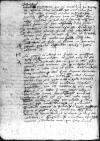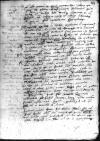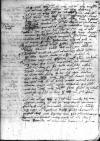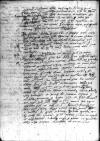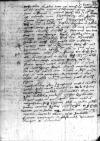Per ⌊⌋ ⌊hinc⌋ scripsi Maiestati Vestrae Serenissimae 1527-11-15⌊XV-a Novembris praeteriti1527-11-15⌋ ea, quae tum hic agebantur. Ab eo tempore nulla certa posta se offerebat ob istorum bellorum turbinem, cu illegible⌈[u]u illegible⌉m[1] qua tuto scribere potuerim. Quae interea hic acta sunt, sic habent.
Post adventum ⌊Baiart⌋, secretarii ⌊regis christianissimi⌋, cum quo certae pacis condiciones exspectabantur, tractatum est per oratores Ligae continue ms. continuae(!)
⌈continuecontinue ms. continuae(!)
⌉ apud ⌊caesarem⌋ de pace hac conficienda. Quibus tandem ad eum modum, ut in hac carta inclusa habetur, prima die huius mensis atque novi anni, in scriptis fuit per dominum ⌊magnum cancellarium⌋ responsum, unde cognoscet, quantum adhuc ab hac pace distamus, deditque mihi dominus cancellarius exemplum huius responsi, ut hoc ad Maiestatem Vestram Serenissimam transmitterem, quo edoceretur nihil per maiestatem caesaream stetisse, quin pax haec concluderetur; nihilo secius tamen, cum prius illi fuerit impositum, prudentius in his tractatibus egisse, utpote quod ⌊obsides ⌋ hinc abire non permittet, donec pecuniae duo milliones, ut in carta habetur, integrae numerentur et exercitus ex ⌊Italia⌋, restituta ⌊Genua⌋, cum aliis interceptis revocetur. Quod ⌊Galli⌋ facere nolunt, quousque[2] ⌊obsides⌋ hic sunt, nisi prius illi restituerentur. Ab utraque parte Graeca mercantur[3] fide. Hic quibus prius fuit impositum, non abs re metuunt, illi qui sibi sunt conscii, talionem timent. Sic
cf. Verg. A. 4. 373 ⌊nusquam tuta fidescf. Verg. A. 4. 373 ⌋. Unde ad tractandum hanc securitatem ⌊unus oratorum Gallorum, episcopus de ⌊Terua⌋⌋, cum hoc responso ad ⌊regem
 BNW, BOZ, 2053, TG 8, No. 892, f. 64v
christianissimum⌋ proficiscetur, quo sic tractando, ut hic passim omnes suspicantur, tempus redimentes, per quod rebus suis in omnem eventum commodius consulere possint. Sit quodcumque, etiam ego firmus haereo in sententia domini ⌊magni cancellarii⌋, qui sub his condicionibus numquam pacem futuram sperat, nisi serio aliquando rem ⌊caesar⌋ gerat, qui hactenus ad omnia connivere visus est. Credo etiam (quod hic credunt plurimi) firmam inter istos duos ⌊principes⌋ pacem fieri non posse, quam diu sunt in vivis, adeo in sese animos exulceratos gerunt; manet cf. Verg. A. 1. 26 ⌊alta mente repostumcf. Verg. A. 1. 26 ⌋
et fides non servata, et ignominia percepta, quae duo difficulter utrumque[4] possunt obliterari etc.
BNW, BOZ, 2053, TG 8, No. 892, f. 64v
christianissimum⌋ proficiscetur, quo sic tractando, ut hic passim omnes suspicantur, tempus redimentes, per quod rebus suis in omnem eventum commodius consulere possint. Sit quodcumque, etiam ego firmus haereo in sententia domini ⌊magni cancellarii⌋, qui sub his condicionibus numquam pacem futuram sperat, nisi serio aliquando rem ⌊caesar⌋ gerat, qui hactenus ad omnia connivere visus est. Credo etiam (quod hic credunt plurimi) firmam inter istos duos ⌊principes⌋ pacem fieri non posse, quam diu sunt in vivis, adeo in sese animos exulceratos gerunt; manet cf. Verg. A. 1. 26 ⌊alta mente repostumcf. Verg. A. 1. 26 ⌋
et fides non servata, et ignominia percepta, quae duo difficulter utrumque[4] possunt obliterari etc.
Dominus ⌊magnus cancellarius⌋, ut scripsi in ⌊⌋, postquam ex ⌊Genua⌋ rediisset ad ⌊caesarem⌋, primum bene fuit habitus et paulo post per eos, qui in illum conspiraverant, male tractatus, sic quod a caesare longo satis tempore in rebus suis non potuit habere responsum fuitque eo redactus, quod iterum curiam linquere decreverat implicatus tot debitis, quae valorem 30 milium ducatorum excedunt. Cum vero ⌊caesar⌋ in his cum ⌊Gallis⌋ tractatibus fidem, integritatem et ⌊illius⌋ prudentiam singularem perspexisset, coepit illi confidentius quam prius umquam fidere, et cum eo libentius quam antea seorsum colloqui et quosdam suos errores fateri. Quod cum aemuli ⌊eius⌋ viderent et gratiam ⌊caesaris⌋ erga illum in dies augeri, inierunt consilium, ut caesari persuaderent, quod illum hoc tempore post mortem ⌊viceregis⌋ cum quibusdam commissionibus mitteret in ⌊Italiam⌋. Id cum ⌊caesar⌋ perspexisset, ingenue cum ⌊cancellario⌋ desuper contulit, et omnium[5] suorum technas illi aperuit. Unde cum eo convenit, quod ⌊ille⌋, qui hoc moliebatur, cum commissionibus ipsi ⌊cancellario⌋ placituris mitteretur, cancellarius vero, quo ⌊caesar⌋ commode
 BNW, BOZ, 2053, TG 8, No. 892, f. 65r
non potest carere, in curia remanebit. Iturus est itaque his diebus dominus ⌊Ioannes Emanuel⌋ in ⌊Italiam⌋, ut turbas has utcumque componat, et cum ⌊pontifice⌋ omnia transigat, quae ad illius liberationem, et quo in fide retineatur, spectabunt.
BNW, BOZ, 2053, TG 8, No. 892, f. 65r
non potest carere, in curia remanebit. Iturus est itaque his diebus dominus ⌊Ioannes Emanuel⌋ in ⌊Italiam⌋, ut turbas has utcumque componat, et cum ⌊pontifice⌋ omnia transigat, quae ad illius liberationem, et quo in fide retineatur, spectabunt.
Exercitui caesareo in ⌊Italia⌋ praefectus est capitaneus generalis dominus ⌊princeps de Orange⌋, vir iuvenis et acer, atque rerum bellicarum satis peritus; is superioribus annis fuit captus in ⌊Gallia⌋ et subinde per captivitatem ⌊regis⌋ liberatus, convaluitque ex vulnere, quod in captione ⌊urbis⌋[6] acceperat. Missaque sunt a ⌊caesare⌋ pro eo exercitu quattuor centena milia ducatorum, quibus se aliquamdiu sustinere poterit. Item missa centum milia ducatorum pro recentibus militibus in ⌊Germaniam⌋, et hinc modis omnibus conquiruntur pecuniae, quo certum habeo, ut ipse dominus ⌊cancellarius⌋ mihi retulit, quod ⌊caesar⌋ omnino hoc anno iturus est in ⌊Italiam⌋, sive pax fiat, sive novum bellum incrudescat. Quapropter ⌊caesar⌋ in fine istius mensis hinc versus ⌊Valentiam⌋ est iturus, habebitque, si ex ea parte solvere voluerit, 50 triremes bene armatas ms. armatos(!)
⌈armatasarmatas ms. armatos(!)
⌉ praeter alias naves. Si vero sibi commodum non videbitur, parabit classem ab altera parte, quasi ⌊Belgis⌋ suis contra ⌊Gallos⌋ missurus suppetias, et praeter omnium opinionem traicient in ⌊Flandriam⌋. Inde sibi iunctis Germanis principibus in ⌊Italiam⌋ iturus, hocque certo credat futurum Maiestas Vestra Serenissima, quandoquidem ab ipso fonte, non a rivulis id hausi.
Praeterea mittit hinc his diebus ⌊maiestas caesarea⌋ ad ⌊regem Angliae⌋ alium suum oratorem, cum prius semper[7] unum habeat, virum industrium et bene doctum ex consilio Aragoniae, cui ⌊Maio⌋ nomen est. ⌊Is⌋ proficiscitur
 BNW, BOZ, 2053, TG 8, No. 892, f. 65v
ad illum ⌊regem⌋, quo eum contineat, ne hostis fiat, et ut eum novis quibusdam condicionibus a ⌊Gallis⌋ abstrahat, et ⌊maiestati caesareae⌋ devinciat. Amicitia inter ⌊Anglos⌋ et ⌊Gallos⌋ numquam solet esse perpetua, cum alias inter eos semper fuerit odium inexstinguibile.
BNW, BOZ, 2053, TG 8, No. 892, f. 65v
ad illum ⌊regem⌋, quo eum contineat, ne hostis fiat, et ut eum novis quibusdam condicionibus a ⌊Gallis⌋ abstrahat, et ⌊maiestati caesareae⌋ devinciat. Amicitia inter ⌊Anglos⌋ et ⌊Gallos⌋ numquam solet esse perpetua, cum alias inter eos semper fuerit odium inexstinguibile.
In his tractatibus ⌊oratores⌋ ⌊regis Angliae⌋ habent plenum mandatum, pro octo centenis milibus ducatorum reliquis ⌊maiestati caesareae⌋ fideiubere, quod quidem susceptum est, sed de securitate, quod ⌊Genua⌋ cum aliis interceptis post obsidum dimissionem deberet restitui, nihil hucusque potuit concludi. Licet ⌊rex christianissimus⌋ offerat post duodecim centena illa milia ducatorum persoluta, velle relinquere ⌊filios⌋ suos obsides in manibus ⌊regis Angliae⌋, tam diu donec ⌊Genua⌋ cum aliis restituendis in potestatem ⌊caesaris⌋ deveniret, et exercitus cum domino ⌊de Lutrecht⌋ ex ⌊Italia⌋ in ⌊Galliam⌋ retraheretur. Quod si non fieret certo et statuto tempore, ⌊rex Angliae⌋ ⌊obsides⌋ ⌊caesari⌋ remitteret. Ad haec a ⌊caesare⌋ responsum est, quod eodem modo vult dare ⌊regem Angliae⌋ fideiussorem, cum primum haec summa est persoluta, ac ⌊Genua⌋ cum aliis restituta et exercitus in ⌊Galliam⌋ reductus, quod subinde etiam ad statutum terminum remittet ⌊regi christianissimo⌋ ⌊obsides⌋. Super his agitur adhuc. De fide est negotium, et cum iam hoc turbulentissimo nostro tempore nemini tuto fiditur, praesertim ubi de magnis rebus fit actio, timeo, ne quid intercidat.
His diebus cum aliquoties dominum ⌊magnum cancellarium⌋ convenirem, ratione solutionis adohae, ut ab ea ⌊reginalis maiestas⌋ redderetur immunis. Retulit mihi aperte, quomodo hic ⌊oratores Galli⌋ passim se iactarent, Maiestatem Vestram Serenissimam cum ⌊rege christianissimo⌋ arctum foedus confecisse per medium ⌊Antonii Rinconis⌋, qui hic alias, quia a ⌊caesare⌋ ... superinscribed⌈... illegible⌈...... illegible⌉... superinscribed⌉ defecit,
turpe nomen obtinuit,
 BNW, BOZ, 2053, TG 8, No. 892, f. 66r
et quod Maiestas Vestra Serenissima in omnem eventum ipsum regem, quoad eius fieri posset, non esset desertura. Ad quae ego, cum etiam ea ab aliis prius audivissem, forte fortuna ⌊⌋ Maiestatis Vestrae Serenissimae XV-a Augusti ⌊Cracoviae⌋ datas mecum habens ⌊illi⌋ ostendi omnemque hanc historiam de[8] ⌊palatino Siradiensi⌋ et de ipso ⌊Antonio⌋ declaravi, annectens ea, quae ad id mihi videbantur expedire. Unde cum has ad me ⌊⌋ Maiestatis Vestrae Serenissimae usque ad calcem accurate perlegisset, subintulit: “hic longe diversum habetur ab his, quam ⌊Galli oratores⌋ praedicant, dicunt tamen, inquit, quod idem ⌊palatinus⌋ usque ad praesens a ⌊rege vestro⌋ apud ⌊regem Galliae⌋ oratorem agat. Atqui contrarium habent ⌊⌋ vestrae, quae ⌊illum⌋ et ardelionem vocant, et quemadmodum dicunt in fine, quod illius legatio facta sit sine scientia et voluntate ⌊regis vestri⌋ esseque suae serenitati plurimum molestam neque aliquando fore omnino impunitam, ita futurum credo ⌊caesarique⌋ ea hic hodie in consilio referam.” Hactenus ⌊cancellarius⌋, ad quae respondi ea, quae bene conveniebant, fuitque de his ⌊⌋ optime contentus. Haec ideo Maiestatem Vestram Serenissimam non latere volui, licet apud nostros, si ad huius partis notitiam pervenerint, ingens odium mihi concitabunt, quo fidei meae erga maiestatem vestram serenissimam satis factum cognoscatur, nemo est, cui plus in terris, quam Maiestati Vestrae Serenissimae debeam.
BNW, BOZ, 2053, TG 8, No. 892, f. 66r
et quod Maiestas Vestra Serenissima in omnem eventum ipsum regem, quoad eius fieri posset, non esset desertura. Ad quae ego, cum etiam ea ab aliis prius audivissem, forte fortuna ⌊⌋ Maiestatis Vestrae Serenissimae XV-a Augusti ⌊Cracoviae⌋ datas mecum habens ⌊illi⌋ ostendi omnemque hanc historiam de[8] ⌊palatino Siradiensi⌋ et de ipso ⌊Antonio⌋ declaravi, annectens ea, quae ad id mihi videbantur expedire. Unde cum has ad me ⌊⌋ Maiestatis Vestrae Serenissimae usque ad calcem accurate perlegisset, subintulit: “hic longe diversum habetur ab his, quam ⌊Galli oratores⌋ praedicant, dicunt tamen, inquit, quod idem ⌊palatinus⌋ usque ad praesens a ⌊rege vestro⌋ apud ⌊regem Galliae⌋ oratorem agat. Atqui contrarium habent ⌊⌋ vestrae, quae ⌊illum⌋ et ardelionem vocant, et quemadmodum dicunt in fine, quod illius legatio facta sit sine scientia et voluntate ⌊regis vestri⌋ esseque suae serenitati plurimum molestam neque aliquando fore omnino impunitam, ita futurum credo ⌊caesarique⌋ ea hic hodie in consilio referam.” Hactenus ⌊cancellarius⌋, ad quae respondi ea, quae bene conveniebant, fuitque de his ⌊⌋ optime contentus. Haec ideo Maiestatem Vestram Serenissimam non latere volui, licet apud nostros, si ad huius partis notitiam pervenerint, ingens odium mihi concitabunt, quo fidei meae erga maiestatem vestram serenissimam satis factum cognoscatur, nemo est, cui plus in terris, quam Maiestati Vestrae Serenissimae debeam.
Cum his ad me Maiestatis Vestrae Serenissimae ⌊⌋ multis hic ora obstruxi valdeque ad haec tempora mihi fuerunt opportuna, factumque est inde, quod innovationes commissionum et litterarum super ⌊castro⌋ et castellano Barensi facilius obtinuerim, praesertim illarum, quas superiori anno praesente adhuc ⌊vicerege⌋ ⌊Granatae⌋ impetraveram misique paulo ante omnium illarum unas ⌊Neapolim⌋ ad manus domini ⌊Scipionis de Summa⌋,
 BNW, BOZ, 2053, TG 8, No. 892, f. 66v
subinde duplicatas alias missurus. Speroque, quod cum hoc ⌊castro⌋ et castellano praeficiendo, in quem iam ⌊maiestas reginalis⌋ consensit, per has innovatas commissiones propediem finis habebitur. Quo fiet, quod tantis hic expensis Maiestatis Vestrae Serenissimae non erit opus amplius, et ... illegible⌈...... illegible⌉ me, cum gratia sua, quod summopere cupio, post quartum annum tum demum revocare dignabitur.
BNW, BOZ, 2053, TG 8, No. 892, f. 66v
subinde duplicatas alias missurus. Speroque, quod cum hoc ⌊castro⌋ et castellano praeficiendo, in quem iam ⌊maiestas reginalis⌋ consensit, per has innovatas commissiones propediem finis habebitur. Quo fiet, quod tantis hic expensis Maiestatis Vestrae Serenissimae non erit opus amplius, et ... illegible⌈...... illegible⌉ me, cum gratia sua, quod summopere cupio, post quartum annum tum demum revocare dignabitur.
De solutione adohae remittenda, ut scripsi, parum mihi spei est, quod de mera gratia ⌊caesar⌋ eam condonare debeat, nisi iura desuper aut approbatam consuetudinem vel gratiam litteris firmatam habeamus, quemadmodum de ⌊⌋ ex meis ad ⌊reginalem maiestatem⌋ latius Maiestas Vestra Serenissima intelliget.
In festis istis[9] praeteritis cum strenis, vel ut potius dicam, cum pensionibus, quas hic quolibet anno expendere cogor, praeterea pro pannis, quibus vestivi familiam, ac pro aliis rebus ad cotidianum usum necessariis, non parvam summam pecuniarum extraordinarie exposui, ordinarie revera vix centum ducatis domum sustineo, nihilque fit extra legitimum modum, nisi ut auctoritas Maiestatis Vestrae et serenissimae suae ⌊coniugis⌋ apud istas hic nationes debito suo sub decoro conservaretur. Mensa sub nomine Maiestatis Vestrae Serenissimae et sub ea persona, quam fero, apud me habetur libera. Veniuntque ad me plerumque viri principes et primi de camera ⌊caesaris⌋, qui ad alios oratores, qui hostes sunt, non solent devertere, me unum sub nomine Maiestatis Vestrae Serenissimae amicum hic agere asserentes, unde ut Maiestati Vestrae Serenissimae honorem faciant, me conveniunt saepius. Quo natum est, cum prius {sic} a multis sic quaeri solebat, ⌊Polonia⌋ qualis et quam magna esset civitas, quod iam passim scitur et regnum esse amplissimum, habereque ⌊regem⌋, qui aetate et prudentia omnibus aliis praestat. Qua de re non pauca a me  BNW, BOZ, 2053, TG 8, No. 892, f. 67r exponuntur, cum quibus mea etiam transeunt, tantum abest, ut hic possim reponere thesauros. Accepi itaque iterum a ⌊Fuccaris⌋ in mutuum, postquam illis 150-ta ducatos ex ⌊Columba⌋ mea persolvissem, alios ducentos ducatos, super quos meum chirographum[10], ideoque Maiestati Vestrae Serenissimae humillime supplico, dignetur de stipendio equorum meorum, quod iam mihi ab annis quattuor debetur, clementer committere, quod istiusmodi 200 ducati in auro ⌊Georgio Hegel⌋ persolverentur, quod cum primum huc scripserit huiusmodi ducatos se[11] percepisse, subinde hic mihi chirographus meus reddetur. Superiori anno etiam in ⌊Granata⌋, postquam frater meus ⌊Bernardus⌋ ex ⌊Gdano⌋ a Maiestate Vestra Serenissima ad me applicuisset, accepi similiter a ⌊Fuccaris⌋ 200 ducatos, quorum centum conversi fuere in usum Maiestatis Vestrae Serenissimae; reliquos centum ducatos mihi usurpavi ms. usurpari(!)
⌈usurpaviusurpavi ms. usurpari(!)
⌉, petiique eosdem in servitio equorum meorum defalcari. Sic cum ad praesens isti ducenti ⌊Georgio Hegel⌋ fuerint persoluti, fatebor me super stipendio meo a Maiestate Vestra Serenissima trecentos ducatos in auro percepisse, quo mihi, cum aliquando sospes ad Maiestatem Vestram Serenissimam rediero, parum de reliquo supererit.
BNW, BOZ, 2053, TG 8, No. 892, f. 67r exponuntur, cum quibus mea etiam transeunt, tantum abest, ut hic possim reponere thesauros. Accepi itaque iterum a ⌊Fuccaris⌋ in mutuum, postquam illis 150-ta ducatos ex ⌊Columba⌋ mea persolvissem, alios ducentos ducatos, super quos meum chirographum[10], ideoque Maiestati Vestrae Serenissimae humillime supplico, dignetur de stipendio equorum meorum, quod iam mihi ab annis quattuor debetur, clementer committere, quod istiusmodi 200 ducati in auro ⌊Georgio Hegel⌋ persolverentur, quod cum primum huc scripserit huiusmodi ducatos se[11] percepisse, subinde hic mihi chirographus meus reddetur. Superiori anno etiam in ⌊Granata⌋, postquam frater meus ⌊Bernardus⌋ ex ⌊Gdano⌋ a Maiestate Vestra Serenissima ad me applicuisset, accepi similiter a ⌊Fuccaris⌋ 200 ducatos, quorum centum conversi fuere in usum Maiestatis Vestrae Serenissimae; reliquos centum ducatos mihi usurpavi ms. usurpari(!)
⌈usurpaviusurpavi ms. usurpari(!)
⌉, petiique eosdem in servitio equorum meorum defalcari. Sic cum ad praesens isti ducenti ⌊Georgio Hegel⌋ fuerint persoluti, fatebor me super stipendio meo a Maiestate Vestra Serenissima trecentos ducatos in auro percepisse, quo mihi, cum aliquando sospes ad Maiestatem Vestram Serenissimam rediero, parum de reliquo supererit.
Inter scribendum ista significavit mihi dominus ⌊cancellarius⌋ venisse hodie novum: ⌊pontificem⌋ ex ⌊Mole Adriani⌋ liberatum, datis militibus centum milibus ducatorum, pro quibus habendis 4 paulo ante creasset cardinales et quod nescio ad quod oppidum extra ⌊urbem⌋ commigrasset. Item quod caesariani ibidem in ⌊Italia⌋ quandam partem exercitus Gallici profligassent, et quod classis Veneta, quae in ⌊Sicilia⌋ nuper frumenta coemerat atque acceperat, tempestatibus adacta, circa ⌊Sardiniam⌋ fecerat naufragium, cum inaestimabili ⌊Venetorum⌋ damno et detrimento.
 BNW, BOZ, 2053, TG 8, No. 892, f. 67v
Venerunt hic nuper duo oratores ⌊ducis Lothoringiae⌋, qui licet sit hostis et Gallus, tamen ratione imperii, a quo quaedam iure feudi possidet, importuno quidem tempore, si pax non erit, huc confugit, quandoquidem malum sibi ex finibus ⌊Elsatiae⌋ non abs re timet. Superiori anno opera ⌊ipsius⌋, ut dicitur, sub salvo conductu, quem ipse dux dederat, multa milia rusticorum in finibus ⌊Lothoringiae⌋ fuerunt occisa, estque quidam ⌊Michael Otto⌋ mihi bene notus, qui machinis et tormentis praeclarissimi olim domini ⌊Maximiliani⌋ caesaris praeesse solebat, is etiam nescio quid iniuriarum contra ⌊ducem Lothoringiae⌋ et ⌊fratrem⌋ eius, cardinalem Franciae, episcopum Mettenensem, habere praetendit illisque hostilitatem indixit, unde timetur, ne collectis rusticis, quorum amici occubuerunt, et quibusdam comitibus his oris adiacentibus, quiddam perniciosum in terras ⌊ducis⌋ moliatur. Idcirco petunt a ⌊caesare⌋, ut causam hanc cum ipso ⌊Michaele⌋ sua maiestas ad suum in ⌊Germaniam⌋ adventum velit suspendere. Credo, quod in his, si pax non fiet, nihil etiam assequentur.
BNW, BOZ, 2053, TG 8, No. 892, f. 67v
Venerunt hic nuper duo oratores ⌊ducis Lothoringiae⌋, qui licet sit hostis et Gallus, tamen ratione imperii, a quo quaedam iure feudi possidet, importuno quidem tempore, si pax non erit, huc confugit, quandoquidem malum sibi ex finibus ⌊Elsatiae⌋ non abs re timet. Superiori anno opera ⌊ipsius⌋, ut dicitur, sub salvo conductu, quem ipse dux dederat, multa milia rusticorum in finibus ⌊Lothoringiae⌋ fuerunt occisa, estque quidam ⌊Michael Otto⌋ mihi bene notus, qui machinis et tormentis praeclarissimi olim domini ⌊Maximiliani⌋ caesaris praeesse solebat, is etiam nescio quid iniuriarum contra ⌊ducem Lothoringiae⌋ et ⌊fratrem⌋ eius, cardinalem Franciae, episcopum Mettenensem, habere praetendit illisque hostilitatem indixit, unde timetur, ne collectis rusticis, quorum amici occubuerunt, et quibusdam comitibus his oris adiacentibus, quiddam perniciosum in terras ⌊ducis⌋ moliatur. Idcirco petunt a ⌊caesare⌋, ut causam hanc cum ipso ⌊Michaele⌋ sua maiestas ad suum in ⌊Germaniam⌋ adventum velit suspendere. Credo, quod in his, si pax non fiet, nihil etiam assequentur.
Alia pro hac temporis angustia non restant, quam quod <me>[12] suppliciter Maiestati Vestrae Serenissimae ut domino meo colendissimo commendo atque rogo, velit aliquando, ubi occasio se offeret, diuturnorum et fidelium meorum servitiorum reminisci, quo cum passionibus meis arthriticis, quae, uti solent, cum ceperint quempiam, non facile deserunt, post tot curas et labores quiescere possim.
 BNW, BOZ, 2053, TG 8, No. 892, f. 64r
BNW, BOZ, 2053, TG 8, No. 892, f. 64r
 BNW, BOZ, 2053, TG 8, No. 892, f. 64v
christianissimum
BNW, BOZ, 2053, TG 8, No. 892, f. 64v
christianissimum BNW, BOZ, 2053, TG 8, No. 892, f. 65r
non potest carere, in curia remanebit. Iturus est itaque his diebus dominus
BNW, BOZ, 2053, TG 8, No. 892, f. 65r
non potest carere, in curia remanebit. Iturus est itaque his diebus dominus  BNW, BOZ, 2053, TG 8, No. 892, f. 65v
ad illum
BNW, BOZ, 2053, TG 8, No. 892, f. 65v
ad illum  BNW, BOZ, 2053, TG 8, No. 892, f. 66r
et quod Maiestas Vestra Serenissima in omnem eventum ipsum regem, quoad eius fieri posset, non esset desertura. Ad quae ego, cum etiam ea ab aliis prius audivissem, forte fortuna cf.
BNW, BOZ, 2053, TG 8, No. 892, f. 66r
et quod Maiestas Vestra Serenissima in omnem eventum ipsum regem, quoad eius fieri posset, non esset desertura. Ad quae ego, cum etiam ea ab aliis prius audivissem, forte fortuna cf.  BNW, BOZ, 2053, TG 8, No. 892, f. 66v
subinde duplicatas alias missurus. Speroque, quod cum hoc
BNW, BOZ, 2053, TG 8, No. 892, f. 66v
subinde duplicatas alias missurus. Speroque, quod cum hoc  BNW, BOZ, 2053, TG 8, No. 892, f. 67r exponuntur, cum quibus mea etiam transeunt, tantum abest, ut hic possim reponere thesauros. Accepi itaque iterum a
BNW, BOZ, 2053, TG 8, No. 892, f. 67r exponuntur, cum quibus mea etiam transeunt, tantum abest, ut hic possim reponere thesauros. Accepi itaque iterum a  BNW, BOZ, 2053, TG 8, No. 892, f. 67v
Venerunt hic nuper duo oratores
BNW, BOZ, 2053, TG 8, No. 892, f. 67v
Venerunt hic nuper duo oratores  BNW, BOZ, 2053, TG 29, No. 3873, f. 288
Cum istas vellem occludere, relatum mihi est eadem hora per medium domini
BNW, BOZ, 2053, TG 29, No. 3873, f. 288
Cum istas vellem occludere, relatum mihi est eadem hora per medium domini 
